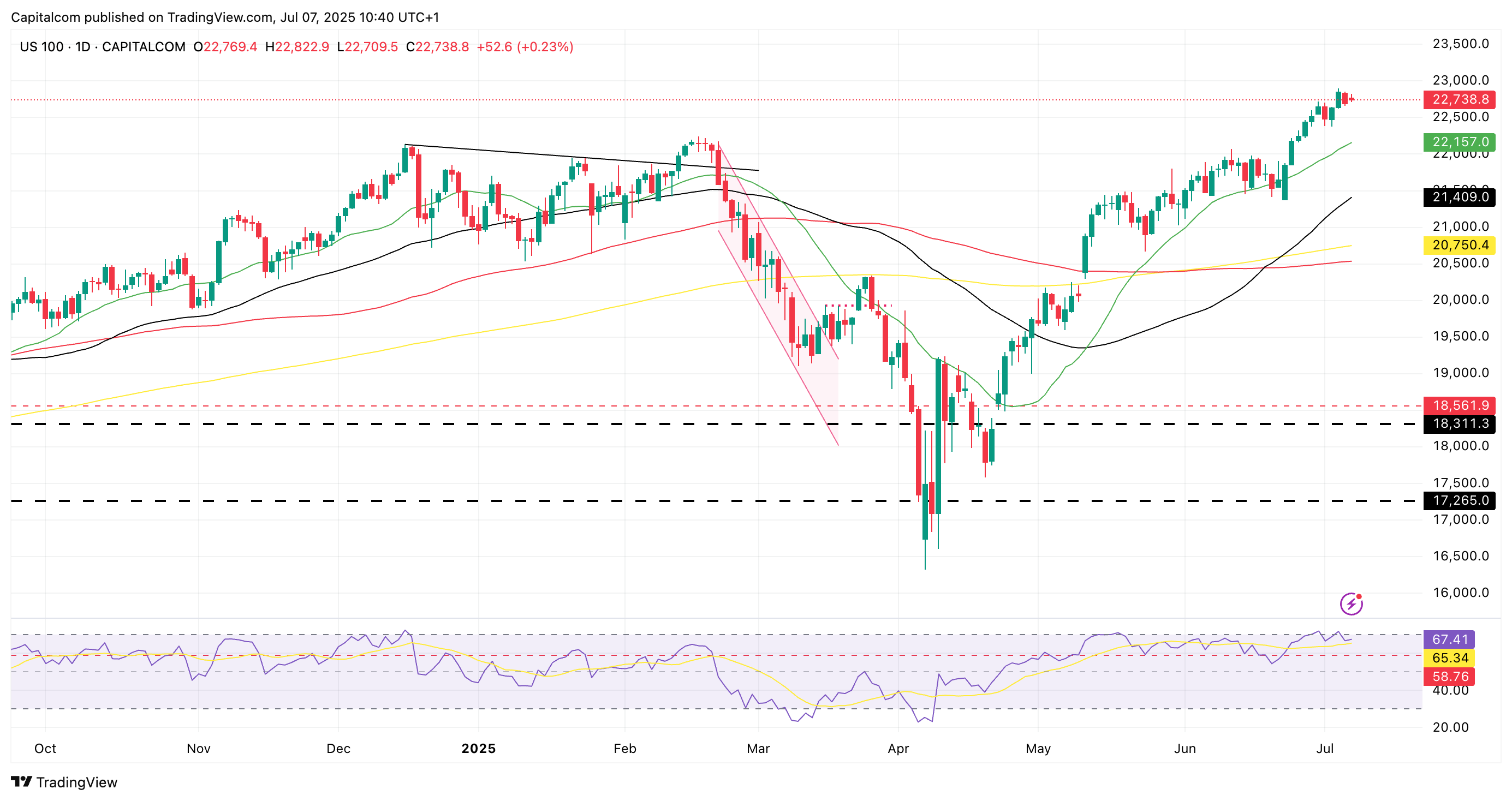Market Mondays: Trade Deadlines, Market Sentiment, and U.S. Resilience
US equities continue to push to new highs as market sentiment remains strong heading into the key July 9 tariff extension deadline
As markets edge closer to a pivotal trade deadline, investors are weighing rumours, partial deals, and the potential for last-minute extensions. Amid these developments, optimism in U.S. equity markets remains strong—but so do the risks.
Trade Talks: Progress or Posturing?
The latest chatter suggests that the U.S. government may offer an extension to key trading partners in an effort to finalize agreements that, so far, have been more framework than formal deal. While just three trade deals have been publicly acknowledged, none have fully materialized.
The lull in trade updates over the past six weeks may have stemmed from geopolitical distractions that shifted market focus elsewhere. However, with the deadline just two days away, attention is turning sharply back to trade negotiations. President Trump has indicated that letters to partners are being sent and that a slew of announcements could arrive shortly.
Despite these signs, the situation remains fluid. Markets are pricing in optimism on the basis of three possibilities:
- A last-minute flurry of finalized deals.
- A formal extension period to allow continued negotiation.
- A hybrid outcome—some deals now, some extensions for others.
Reports suggest Japan, South Korea, and parts of Europe are current sticking points.
Market Sentiment
Sentiment in equity markets is currently buoyant. Investors are inclined to buy into news of successful deals or even a pause in hostilities, as this reduces market volatility. However, a surprise—similar to the sharp tariff hike on Liberation Day—could catch investors off guard. Back then, markets were expecting modest tariffs, but reality far exceeded expectations, leading to a sharp reaction.
Treasury official Scott Bessing has added some clarity, saying that absent finalized deals, letters would be sent to notify trading partners of a reversion to April 2 tariff levels. This conditional approach adds another layer of complexity. Market reaction will hinge on which countries receive deals, and which face tariff reimpositions.
Key trading partners like China, the EU, Canada, Japan, and Korea will be especially watched. Positive sentiment is likely to hold if these major players reach agreements—even if deals with smaller economies stall.
Equities Performance: U.S. Leads, Europe and Asia Lag
The U.S. equity markets continue to outshine their global counterparts. The S&P 500 and Nasdaq 100 have reached new highs. In contrast, European indices like the DAX 40 and FTSE 100, as well as Japan’s Nikkei, have struggled.
US 100 daily chart
(Past performance is not a reliable indicator of future results)
This divergence reflects a broader return to U.S. market dominance, fuelled not just by geopolitics but by growth and earnings expectations. Reports indicate EU-U.S. negotiations have faltered, with no breakthrough over the weekend. An extension may be more realistic than a completed deal by the July 9 deadline.
While trade dominates headlines, it's not the sole factor pushing U.S. markets higher. AI and tech sectors have had a significant impact as they have driven strong earnings growth, especially heading into earnings season. Despite trade uncertainties, stellar Q2 results from major tech firms have boosted investor confidence. Earnings per share from leading tech companies outpaced forecasts significantly.
This resilience offsets some of the economic risks that would typically weigh on equities in a high-interest-rate environment.
A key question is: How can equities thrive when interest rates remain high?
This paradox hinges on the growth narrative. High rates generally reduce the present value of future cash flows, hurting valuations. However, when growth is strong, corporate earnings increase and offset this rate pressure. Strong labour market data—such as last week’s jobs report—underscores this resilience in the U.S. economy.
It’s also important to note that bullishness in equities doesn’t necessarily translate to bullishness in bonds. One can be optimistic about stocks while still bearish on long-term treasuries, expecting yields to rise further.
The "Big, Beautiful Bill" and Long-Term Risks
Recently passed legislation—dubbed the "big, beautiful bill"—is expected to boost short-term growth. However, it also adds to the national debt, which could become a concern in the medium term. For now, markets are unfazed, viewing the bill as a pro-growth measure. But in the next six months, watch for sentiment shifts if debt servicing and structural deficits become more pressing.
As the July 9 deadline looms, markets are hoping for extensions, partial agreements, or at least no nasty surprises. If deals with key partners come through—even at lower-than-expected tariff levels—positive sentiment is likely to persist.
At the same time, investors would do well to keep an eye on the broader narrative. Resilient growth, tech-driven earnings, and U.S. market leadership are all crucial components of the current rally. But risks—from trade shocks to rising debt—still lurk.
Stay tuned. The next 48 hours may be decisive.